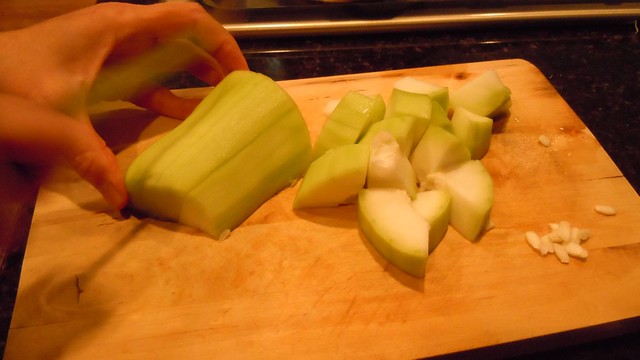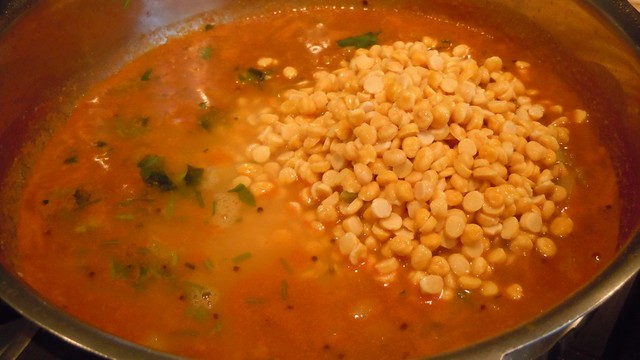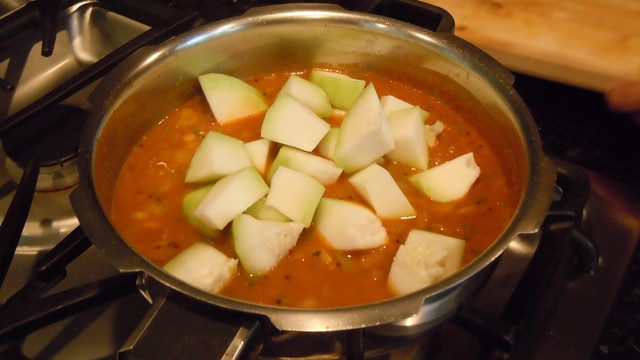Split yellow peas.
Calabash squash, a type of young bottle gourd.
Onions, ginger, and garlic sauteing along with fenugreek, udad dhal, and mustard seeds.
Prepping the calabash squash.
A thicker consistency before adding the split yellow peas.
Thin the dish with enough water to let everything fill out.
Squash chunks get added.
June 14, 2012 update: Laura, of the ever-spectacular Hip Pressure Cooking, was kind enough to share my (mom's) recipe in her Reader Recipes. I've been a fan of pressure cooking for a long time, and her cooker reviews and lessons can be transformational to anyone that cooks. Her approach is to bring this method of cooking to about any cuisine, and after scanning her pics, she pretty much nails them. My personal favorites (those I have bookmarked until I get my own pressure cooker) of Laura's are: tamales, eggs, crema Catalana, and artichokes.
If you're new to pressure cooking, but are intrigued and curious, check out the July 2012 Pressure Cooker Challenge. Join a community of support, build up skills, and share your recipes and techniques.
Mom's dudhi channa shak or yellow split pea and squash curry. One of a dozen recipes I have carefully gleaned on my trip home.
In getting the Gujarati term for this
squash/gourd correct, I did a few web searches, and asked each parent
to spell it before settling on a spelling. Dudhi. Doothi. Doodhi. In Hindi, lauki. Calabash squash is a type of bottle gourd which is used when it's young and
green. If you can find it (usually at an Asian or south Asian market)
peel the skin off and remove the seeds. It's mild, and it holds its shape well in curries or soups which are simmered. However, don't let it scare you off - yellow summer squash or
zucchini squash can be used instead of the calabash squash.
Although the recipe ingredient list
looks long you can omit many of the spices you don't have, or add spices such as increasing the heat with extra jalapenos or red chili powder. First read the recipe all the way through. Soak the lentils first, then prep the ingredients. This soaking time will help reduce the total cooking time of the lentils. This dish can
be cooked in a pressure cooker which can cut cooking time in half, or
can be cooked in a pot on the stove. A pressure cooker is high on my wish list of solid kitchen tools.
The cooking times and directions have been written for stove-top and pressure cooker cooking methods. Serve the finished dish alongside some buttered
hot pita bread, or over rice. Since it's close to Thanksgiving, it would make an excellent vegetarian/vegan main course, or perhaps even a one-pot meal for the weekend. With days of steady rain projected for the Pacific Northwest weather, this dish really hits the spot.
Yellow split pea and calabash squash
curry
(Dudhi channa ni shak)
Yield: 4 servings
Ingredients:
1 cup yellow split peas; soaked in water in a bowl, set aside.
1 tbsp peanut oil
1/4 tsp udad dhal, optional
1/4 tsp fenugreek seeds, optional
1/2 tsp mustard seeds, optional
pinch asafoetida, or hing, optional
1 clove garlic, chopped
1 tbsp ginger, chopped fine
1/2 cup onion, chopped fine
water as needed
2 cups calabash squash, peeled and cut
into 1" chunks. Remove the seeds (ok to substitute unpeeled yellow summer
squash or zucchini squash)
1/3 cup tomato chunks, thinned with
about 2 tbsp of water
1/2 tsp turmeric
1 tsp salt
1 tsp cumin, ground
1 tsp coriander, ground
1/2 cup chopped cilantro, divided, safe
half for garnish
1-2 tsps garam masala, to add just
before serving
red chili flakes to be passed when
served
Directions for stove-top method:
Approx. cooking time: 40 minutes
1. Wash the yellow split peas well. Place them in a medium size bowl and cover them with water.
2. Add the oil to a medium-sized pot, and heat up over medium-high heat. Once the oil is hot, add in the udad dhal, fenugreek and mustard seeds. When the mustard seeds begin to pop (about 1 minute) add in the asafoetida powder. Stir everything together and then add the onions, garlic, and ginger. Continue to saute, turning the heat down to medium. If omitting the optional ingredients, add the onions, garlic, and ginger to the oil and saute until golden.
3. Add the yellow split peas (along with the water they are soaking in) to the pot along with 1-2 cups of water. Add the tomato chunks thinned with a bit of water, turmeric, salt, cumin and coriander.
4. Add the calabash squash chunks (see note below about subbing squashes), and half of the chopped cilantro. Stir everything together and bring to a simmer over medium heat. Let cook 30-35 minutes. Stir it often, and check to see how the lentils and squash are cooking. The dish is done when the lentils are cooked, the squash is easily pierced with a fork, and the dish can be served over rice without being too soupy.
5. Stir in garam masala and the chopped cilantro and serve.
(Note: if subbing in summer squash or zucchini, let the lentils cook for 30-35 minutes before adding the squash in. The curry can be cooked an additional 10 minutes. This will prevent the squash from over cooking and falling apart.
Directions for a pressure cooker:
Approx. cooking time: 25 minutes
Follow steps 1-4 in the directions above, but only add 1 cup of water. Because the pressure cooker cooks everything super fast the extra water is not necessary to accommodate the water that boils off on the stove top. Once you bring the curry to a nice simmer as in step 4, set the pressure cooker to 3 whistles on medium-high heat.
If using summer squash or yellow squash, increase the soaking time of the lentils to 1 hour, and cook the mixture to a max of 2 whistles. It may take some adjustment, but it will prevent the squash from turning into a soggy mess, and should cook the lentils. Finish the dish by stirring in garam masala and chopped cilantro.









you are hereby permitted to cook in my kitchen every day that you are in NC. you're welcome.
ReplyDelete